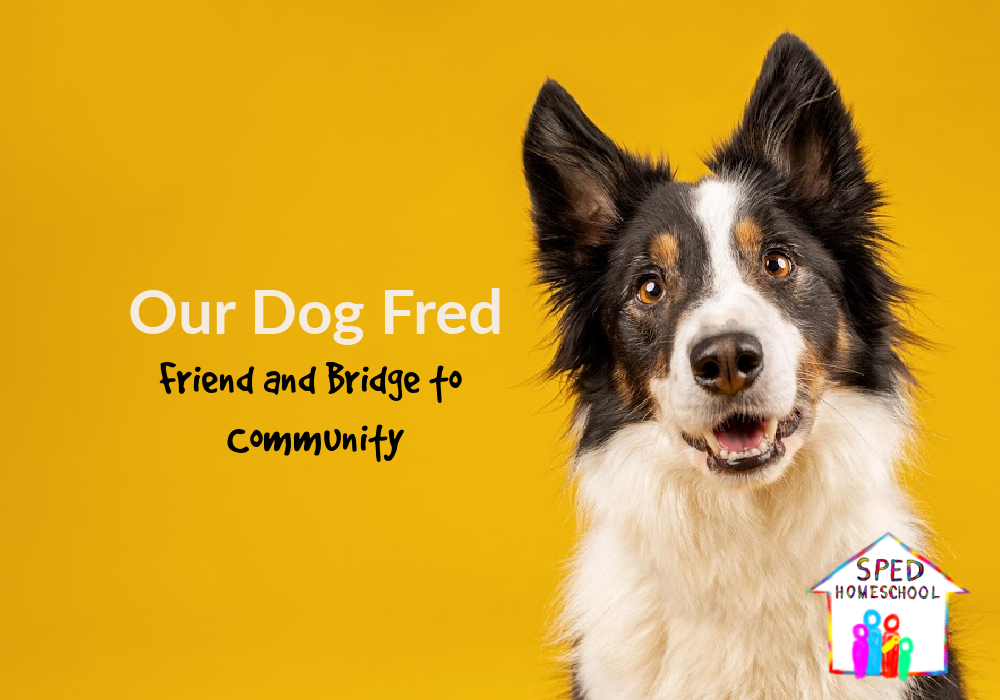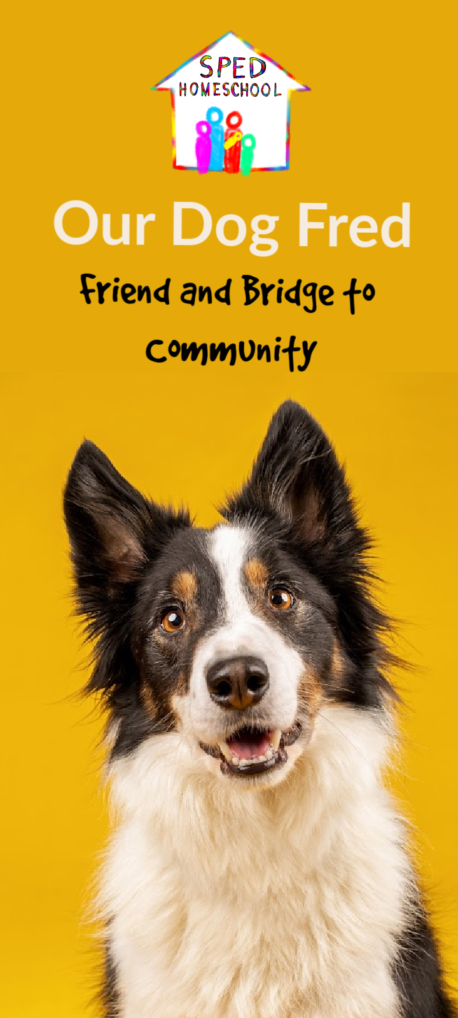
This is Fred.
When he first joined our family he looked like this, which is good, because he was a terror. His beginnings with our family are catalogued in an earlier article.
This post talks about Fred’s work as a service dog with our family, how we all changed because of him, and steps to take if you think a service dog might help you or those you love.
Training and a Different Life
Fred’s work with Corrina, our trainer, proceeded quickly. First, Corrina taught Fred basic obedience and good citizenship skills. Fred obtained the AKC Good Citizenship Certification before we took him into public for training. From there, he learned scenting and tracking skills, how to provide deep and calming pressure on demand, and how to walk Jonathan through public places and traffic safely.
Fred developed keen scenting/tracking skills easily. Learning to calm Jonathan safely and on demand proved more difficult, but Fred picked it up fairly well too. Training Jonathan to stay with Fred in traffic and public places proved more difficult than training Fred to navigate traffic.
Our team (Sue, Corrina, and myself) brainstormed variations of harness and handle operations to find something that finally worked to keep Jonathan at Fred’s side in public. Using a service vest with D-Rings, I attached a clip-on handle for Jonathan to hold as needed. We avoided a harness for him because of the social stigma and safety concerns. When Jonathan understood what we wanted, he easily chose to stay connected to Fred. Staying with Fred was a much more desirable option than enduring mom’s death grip on his wrist!
Fred became adept at the following: finding Jonathan if he ran away, sensing and calming meltdowns, and aiding Jonathan by calming and navigating for him in public places. Children with ASD often run to escape stressful or overwhelming situations. Every outing came with risk. Here is a great article detailing this challenge.
Even in the training phase, Fred’s help began improving our lives. I could grocery shop with much less stress and hypervigilance as Jonathan and Fred walked and waited together. I could give attention to my younger son and know that Fred was helping me watch Jonathan too. Jonathan was much less restless in the store because he could interact with Fred. Parking lots no longer terrorized me because Fred and I shared the load of getting both boys safely into our vehicle. Fred appeared to love the tasks we gave him as it allowed him to accompany our family everywhere, but the focus and work the outings required would tire him after a few hours. I could empathize; outings with two energetic boys wore me out too!
The greatest gift Fred has given us was not the additional safety or help even as life-changing as they were: It was his ability to “bridge the gap” for Jonathan to the community. People love Fred. They are drawn to him. Each outing brought people into our lives because Fred was with us. We went from being stared at in public for meltdowns or odd behavior to attracting people for positive interactions.
Fred’s service vest said, “Service Animal. Please ask before petting me.” People did…by the hundreds. Suddenly social interactions came to us rather than me chasing them down and facilitating them. People’s curiosity drew questions that I would direct to Jonathan because Fred worked for him. Jonathan couldn’t discuss many things easily, but he could talk about Fred all day long…and he did. His language and confidence grew as he had a topic he loved to share with others. His pride in Fred and great love for him showed. The hope that Gross’ book had stirred in my heart a couple of years before became reality.
Fred’s Accomplishments and Retirement
Here are a few career highlights from Fred’s work with our family:
· finding Jonathan after he got lost on a state park trail
· helping save a young friend who got stuck in sand during a high tide
· preventing myriad public meltdowns
· reducing the family’s stress
· helping Jonathan grow into independence in the community
· expanding his work to help my younger son as well
I’d love to tell you many stories about Fred. He is much more than a dog or pet to me. For several years he was a lifeline, an ally, and a dependable friend to us in a world that was often lonely.
The time came that Jonathan’s skills and abilities had grown to no longer require Fred’s assistance. He developed self-calming and regulatory strategies. He could process my directions and understand the dangers around him. My husband said it was time to let Jonathan stand alone and he was right. It hurt and scared me a bit to leave Fred at home, but we did fine. Fred adjusted after time to being our pet and friend though we still take him with us everywhere we can. He still guards Jonathan at night, greets him with joy each morning, and acts as a bridge to the community when he goes out with us.
One memory to end our story: Jonathan was competing in a cross country meet and I brought Fred along to encourage him. As we walked at the park, people from our team and competing teams came over to see Fred.
Teenagers disengaged from their phones to come meet and pet Fred. Many wonderful introductions and conversations were exchanged. One man came running with a glass full of water for Fred just in case he needed it. I’ve never seen anything like the attention and love Fred inspires; many other dogs were around the park, but Fred was the star. He will always be a star to me.
Is a Service Animal Right for Your Family?
While our story might inspire hope in you, I also want to impress upon readers the great work and responsibility that a service animal requires. Here are my tips for assessing if a service animal might be a good option for your family.
1. You must love animals. If you cannot commit to sharing all your day with an animal companion and caring for their needs, find another option.
2. Commit to the investment. Training and care for a service animal is costly. They provide great assistance to your family and it will cost you time, money, and energy in return.
3. Research before you jump. Just because a service animal has helped others, does not mean one will work for your family. Learn and know what you can reasonably expect the dog to do and whether it matches with what you need, can provide for the animal, and the law.
4. Do NOT skimp on training or fake service training for your pet. A disturbing trend has emerged where people get a vest for their pet and call them a service animal. Those of us who have trained and worked with service animals can spot them quickly. They behave like a family pet who has gone out for the day, not as a trained service animal whose focus is on their job. It may be comforting to have your pet with you, but that is not a benefit that rises to federal and state laws. Please don’t jeopardize the reputation and freedom of those benefiting from service animals to perform daily necessities.
5. Recognize that the dog will retire. The day will come when the strenuous work becomes too great for the animal. Compassion and love dictate that you respect the animal’s limitations. Some dogs work longer than others. When it is time for the animal to retire, return the love and support it has provided to you; they have earned it.



